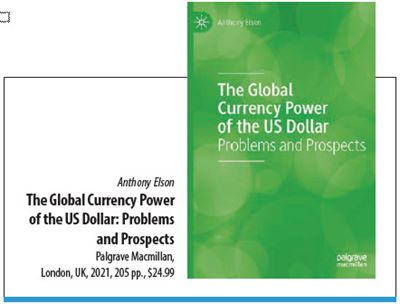The Global Currency Power of the US Dollar: Problems and Prospects

When the COVID-19 pandemic triggered a “risk-off” flight of capital in the spring of 2020, private investors and financial institutions turned to US Treasury bonds as the alternative “safe asset.” The retreat from financial markets was soon reversed, in part because of the Federal Reserve’s formidable response to the threat of a global financial collapse. Fifty years after President Richard Nixon cut the link between gold and the dollar reserves held by foreign central banks, the US dollar continues to play a predominant role in the global financial system, with enormous spillover effects for US monetary policy.
Anthony Elson, a former IMF staff economist, explores the reasons for this phenomenon and the prospects for the future in The Global Currency Power of the US Dollar: Problems and Prospects. He traces the historical roots of the widespread use of the dollar for trade and financial flows to the emergence of the United States as the world’s largest economy after World War II. US financial markets are unequaled in terms of breadth and liquidity, which reinforces the use of the dollar in financial transactions. The widespread usage of the dollar provides an incentive—the network effect—for new users also to adopt it.
Elson methodically lays out the benefits and defects of a dollar-based system. US international traders and investors avoid the cost of foreign exchange transactions and exchange rate risk. The US government can continue to run fiscal deficits with low interest rates because of the demand for US securities. In addition, the cutoff of access to the dollar-based global banking network through sanctions serves as a valuable foreign policy tool.
The vulnerabilities of the system include the dependence on fiscal deficits to supply safe assets to the world. This “new Triffin dilemma” raises the question of whether there is a threshold of debt that would trigger concerns about the sustainability of the US debt. These concerns may become manifest if interest rates rise in 2022 as the Federal Reserve responds to inflation. Moreover, any increases in US interest rates will raise the cost to foreign governments of refinancing their external debt.
What is a feasible alternative to the central role of the dollar? Elson points out that a multiple reserve currency system including the euro and the Chinese yuan could have advantages over the existing dollar-based system. But a number of conditions must be met before those currencies gain more acceptance, and Elson foresees the pace of adaptation and change will be slow. Similarly, the expanded use of the IMF’s Special Drawing Rights depends on reforms in the IMF’s operations and its voting structure, which must be negotiated.
The most interesting alternative to the dollar’s primacy may not be other national currencies but digital currencies. Central banks are actively exploring the use of these electronic means of payment. If a system of payments for international transactions emerges that is seen as safe, stable, and not dependent on any one country, then the dollar’s central role may be replaced by a different form of money altogether.
Opinions expressed in articles and other materials are those of the authors; they do not necessarily reflect IMF policy.








